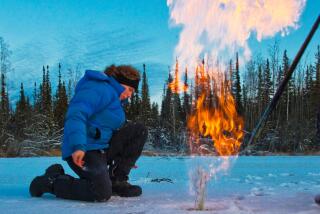‘Cold’ hard facts about life in chilly climes
- Share via
Believe it or not: In the Arctic, some caterpillars freeze in autumn and thaw the next spring, none the worse for wear. Tiny willows struggle so hard to grow, they’re shorter than nearby tundra grass.
To keep warm, otters can have nearly a million hairs per square inch of skin. Bowhead whales burn 10,000 calories a day and can have blubber more than two feet thick.
Alaska biologist Bill Streever has collected these and many other incredible facts in his fascinating new book, “Cold: Adventures in the World’s Frozen Places.”
For a year, Streever, who manages an environmental studies program, explored the science and history of cold, traveling to some of world’s chilliest places.
In July of his research year, for example, he dived into 35-degree Prudhoe Bay, 300 miles north of the Arctic Circle. He tolerated the water only five minutes, going from gasping to shivering to stinging to burning pain while considering animals who cope more successfully with cold.
For instance, some frogs also freeze -- “amphibian Popsicles in the mud. Frogsicles.” Hibernating ground squirrels’ body temperatures approach freezing, periodically triggering a day of drowsy shivering before they fall once again into deep torpor. Common eiders tend eggs on hollows they scrape in sand, successfully raising chicks in nests lined with down plucked from the females’ breasts.
In March, Streever took a winter survival course in Anchorage. Outside, it was 5 below zero; inside, warm and dry, he and his classmates learned they are “leaking heat everywhere.” Sweating and breathing lower body heat; sitting on cold ground removes more heat; failing to wear a hat . . . ditto. Cotton kills, because its fibers hold water; wearing nothing might be less dangerous than wet jeans. Synthetics are better. Better still are wool and fur.
After class, Streever went skiing. His old mittens and liners were thin and full of holes. Soon, his hands were so cold, he ripped open two chemical heat packs, but couldn’t feel if they were working.
Meanwhile, his dog trotted through the snow “with no understanding of frostbite . . . wearing neither synthetic fibers nor cotton, tail arched upward, ears erect, head up. If dogs can smile, he is smiling now.”
The summer release of this book couldn’t be better. For readers facing rolling blackouts, scorching weather and violent storms, Streever’s affection for cold offers intellectual air conditioning.
In August, he headed to Fairbanks to a U.S. Army Corps of Engineers permafrost tunnel built in the 1960s. As a Cold War missile silo, the experiment flopped, but it’s maintained today as a research and education facility.
The earth there has been frozen roughly 40,000 years, making the downward sloping path a musty “walk through time.” Plant roots from the Pleistocene Ice Age as well as bones of long-extinct steppe bison line the walls.
In September, Streever hiked up Scotland’s highest peak, glacier-cut Ben Nevis, where inevitably bad weather prompted comparisons to perilous Antarctic expeditions of Robert Falcon Scott and Ernest Shackleton.
In May, he visited a six-acre oil rig “island” in the Arctic’s Beaufort Sea. The temperature was a balmy 18 degrees, which didn’t stop a dive crew from clearing sea ice from the area. Later that month, though, it was almost 50 in Chugach State Park, where Streever biked then hiked to Eklutna Glacier. Birch and aspen were fully leafed out; saxifrage managed to bloom in bare rock. The ice was full of blue crevasses.
“It looks distinctly like a glacier on its way out,” Streever noted.
On June 20, solstice eve, he returned to the edge of Prudhoe Bay where he started his year of travels. The landscape was brown. Caribou were shedding. Geese and ducks nested again. A seal pup that was near death and rehabilitated was now well enough for release.
“It swims, then pauses,” Streever reports. “It turns to bless us once more with its brown-eyed gaze, then submerges. . . .
“When it reappears a few minutes later, it is heading due north, toward the sea ice. Toward home.”
More to Read
Sign up for The Wild
We’ll help you find the best places to hike, bike and run, as well as the perfect silent spots for meditation and yoga.
You may occasionally receive promotional content from the Los Angeles Times.






